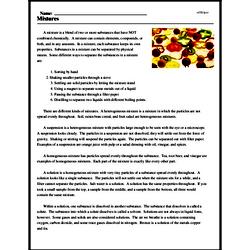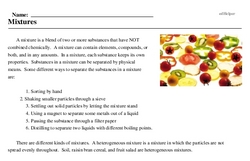Mixtures
A mixture is a blend of two or more substances that have NOT combined chemically. A mixture can contain elements, compounds, or both, and in any amounts. In a mixture, each substance keeps its own properties. Substances in a mixture can be separated by physical means. Some different ways to separate the substances in a mixture are:
1. Sorting by hand
2. Shaking smaller particles through a sieve
3. Settling out solid particles by letting the mixture stand
4. Using a magnet to separate some metals out of a liquid
5. Passing the substance through a filter paper
6. Distilling to separate two liquids with different boiling points.
There are different kinds of mixtures. A heterogeneous mixture is a mixture in which the particles are not spread evenly throughout. Soil, raisin bran cereal, and fruit salad are heterogeneous mixtures.
A suspension is a heterogeneous mixture with particles large enough to be seen with the eye or a microscope. A suspension looks cloudy. The particles in a suspension are not dissolved; they will settle out from the force of gravity. Shaking or stirring will suspend the particles again. The particles can be separated out with filter paper. Examples of a suspension are orange juice with pulp or a salad dressing with oil, vinegar, and spices.




